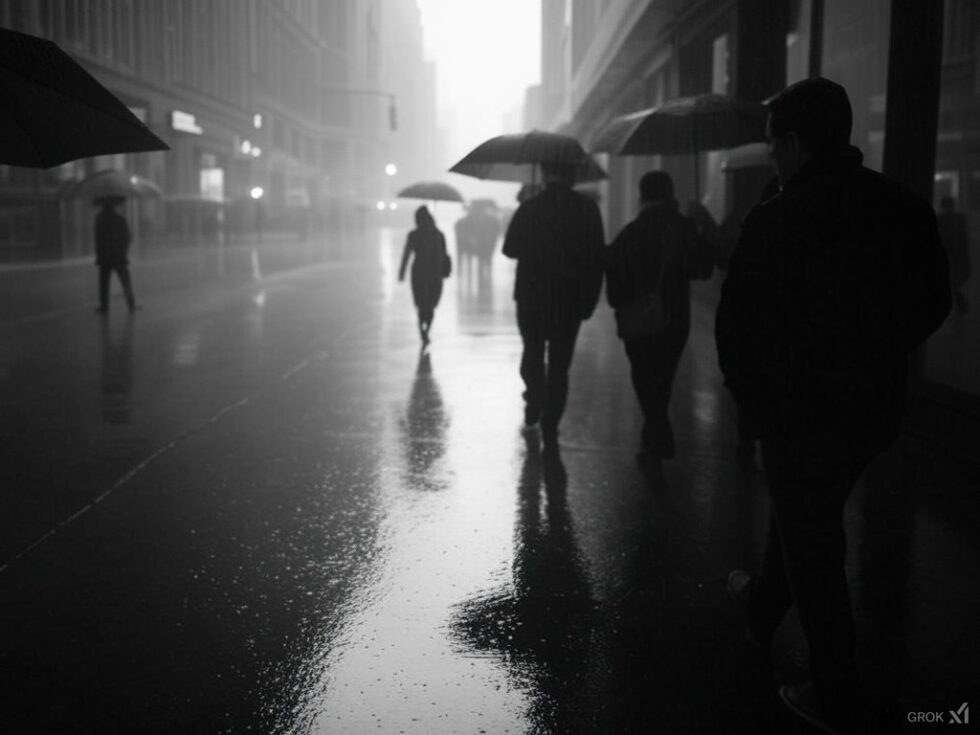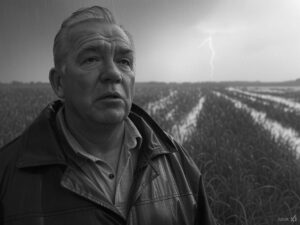
In the early days of the unending rain, people were captivated by its novelty. The rhythmic patter against rooftops became a constant lullaby, soothing the world into a false sense of security. Umbrellas turned into fashion statements, and rain boots were in high demand. Children splashed gleefully in puddles, while adults watched the rain fall with a mix of wonder and apprehension. However, as the weeks turned into months, the charm of the rain began to erode, revealing a more ominous reality.
Agriculture was the first to feel the strain. Fields that once yielded bountiful harvests transformed into waterlogged swamps. Crops drowned under the relentless downpour, unable to breathe or absorb nutrients. Farmers watched helplessly as their livelihoods were washed away, their fields becoming vast, muddy quagmires. The global food supply chain, already delicate, began to fracture. Prices soared as scarcity took hold, and governments scrambled to find solutions. Vertical farming and hydroponics gained traction as alternatives, but these technologies were not yet widespread enough to feed entire populations.

Infrastructure, too, began to buckle under the weight of the constant rain. Roads turned into rivers, and cities struggled to cope with the deluge. Drainage systems, designed for occasional storms, were overwhelmed, leading to widespread flooding. In coastal areas, the relentless rain combined with rising sea levels to create a perfect storm of destruction. Homes were swept away, and entire neighborhoods disappeared beneath the water. The world watched in horror as iconic landmarks were submerged, and the once vibrant streets of major cities became eerily silent canals.
Everyday life became a test of endurance. People adapted to a new normal, where raincoats and waterproof gear were as essential as clothing. Schools and workplaces shifted to virtual platforms, as commuting became increasingly hazardous. The constant rain took a toll on mental health, with the lack of sunlight leading to widespread cases of Seasonal Affective Disorder. Social gatherings dwindled, and isolation became the norm. Yet, in the face of adversity, communities found ways to connect. Online forums and virtual meetups flourished, providing a sense of camaraderie in a world that felt increasingly disconnected.
As the year wore on, the environmental impact of the endless rain became more apparent. Forests, unable to absorb the excess water, began to rot from the inside out. Wildlife struggled to adapt, with many species facing extinction as their habitats were destroyed. The delicate balance of ecosystems was thrown into chaos, and scientists warned of long-term consequences that could alter the planet’s biodiversity forever.
Yet, amidst the challenges, there were glimmers of hope. The rain forced humanity to confront its relationship with the environment, sparking a global movement towards sustainable living. People began to rethink their consumption habits, and renewable energy sources gained unprecedented support. The rain, once a harbinger of despair, became a catalyst for change, inspiring a new generation of environmental activists.
As the year drew to a close, the rain finally began to subside. The first dry day was met with a collective sigh of relief, as people emerged from their homes to bask in the long-forgotten warmth of the sun. The world had been irrevocably changed by the experience, but it had also been united by a shared struggle. Communities came together to rebuild, drawing on the lessons learned during the year of rain.
In the aftermath, humanity emerged stronger and more resilient. The challenges of the past year had fostered innovation and collaboration, leading to advancements in technology and infrastructure that would have been unthinkable before. The rain had tested the limits of human endurance, but it had also revealed the boundless capacity for adaptation and growth.
The year of endless rain became a distant memory, a story passed down through generations as a testament to the resilience of the human spirit. It served as a reminder of the fragility of the world and the importance of living in harmony with nature. As the sun shone brightly once more, humanity looked to the future with renewed hope and determination, ready to face whatever challenges lay ahead.




